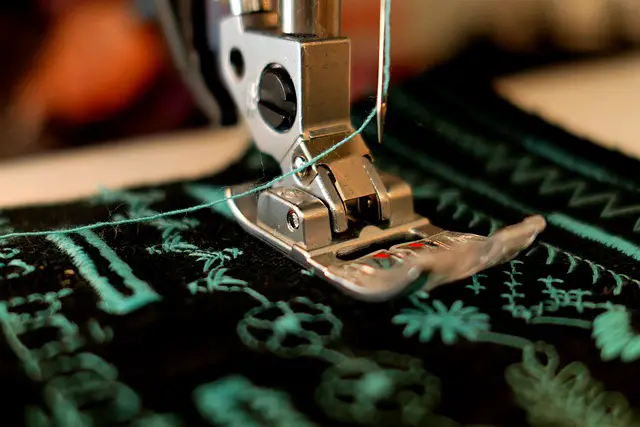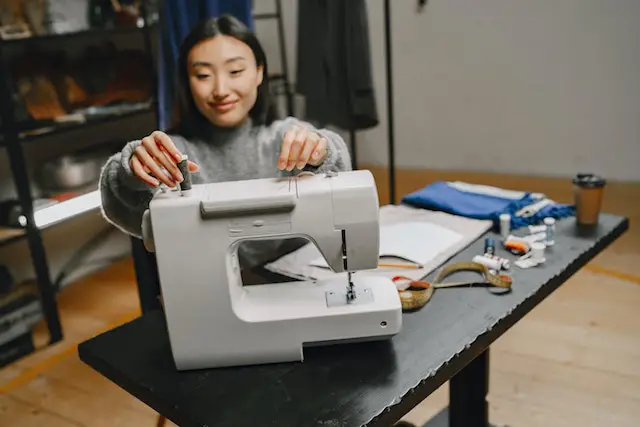How To Unfreeze A Sewing Machine? Simple Steps (2023)

Sewing machines are essential for any seamstress or crafter, but they can be frustrating when they freeze up during a project.
Whether you’re a beginner or an experienced sewer, a frozen sewing machine can be a real headache.
But fear not! With the right knowledge and troubleshooting skills, you can unfreeze your sewing machine and return to your creative pursuits.
In this blog post, we’ll guide you through the basic and advanced troubleshooting steps to help you unfreeze your sewing machine and get it running smoothly again.
So, grab your tools, and let’s dive in!
Understanding the causes of a frozen sewing machine
Before we dive into the steps to unfreeze your sewing machine, it’s important to understand what might be causing the problem. A frozen sewing machine can be caused by several things, including:
· Lack of maintenance: It may become frozen if you haven’t maintained your sewing machine properly.
· Dust and debris: If dust and debris build up in your sewing machine, it can cause it to freeze up.
· Thread jams: Thread jams are a common cause of frozen sewing machines.
· Tension issues: If the tension on your sewing machine is too tight or loose, it can cause it to freeze up.
· Timing issues: If the timing on your sewing machine is off, it can cause it to freeze up.

How To Unfreeze A Sewing Machine? Basic Steps
If your sewing machine is frozen, don’t panic. There are several basic troubleshooting steps you can take to unfreeze it. Here’s what you need to do:
Turn off the Machine
The first step in troubleshooting a frozen sewing machine is to turn it off and unplug it from the power source. This will prevent further damage to the machine and ensure your safety while working on it.
Remove the Thread
The next step is to remove the thread from the machine. If the thread is tangled or bunched up, carefully cut it away with scissors or a seam ripper.
Check the Bobbin
Check the bobbin to ensure it’s wound and inserted properly into the machine. If the bobbin is not wound correctly, unwind and re-wind it, following the manufacturer’s instructions.
Check the Needle
Check the needle to make sure it’s not bent or dull. If it is, replace the needle with a new one.
Clean the Machine
If none of the above steps has fixed the problem, it’s time to clean the machine. Dust and debris can build up inside the machine, causing it to malfunction. Use a soft brush to remove dust and debris from the machine’s exterior and interior.
Lubricate the Machine
If the machine is still frozen after cleaning, lubricating the machine may help. Use a small amount of oil or lubricant to lubricate the machine’s moving parts, following the manufacturer’s instructions.
Plug in the Machine
Once you’ve completed all the troubleshooting steps, plug in the machine and turn it on. Test the machine to ensure it’s working properly.
These basic troubleshooting steps allow you to unfreeze your sewing machine and return to your sewing projects.
Advanced troubleshooting steps to unfreeze your sewing machine
If basic troubleshooting steps fail to unfreeze your sewing machine, it’s time to move on to advanced troubleshooting steps.
These steps require more knowledge and skill, so proceeding cautiously is important. This section will discuss advanced troubleshooting steps to unfreeze your sewing machine.
Check the Belt
The first step is to check the belt. If the belt is loose, worn, or damaged, it can cause the machine to seize up. Check the belt to make sure it’s tight and in good condition. If the belt is loose or damaged, it may need to be replaced.
Check the Motor
If the belt is in good condition, the next step is to check the motor. If the motor is not working properly, it can cause the machine to freeze up.
Check the motor to see if it’s running smoothly. If the motor is making unusual noises or not running, it may need to be repaired or replaced.
Check the Tension
Another potential cause of a frozen sewing machine is improper tension. Check the machine’s tension settings to ensure they’re set correctly.
If the tension is too tight or too loose, it can cause the machine to malfunction.
Check the Timing
If the tension is not the problem, the timing may be off. The timing refers to the synchronization of the needle and the bobbin.
If the timing is off, the machine may be unable to sew properly, causing it to freeze.

Adjusting the timing requires some knowledge and skill, so it’s best to consult the machine’s manual or take it to a professional for repair.
Following these advanced troubleshooting steps, you can unfreeze your sewing machine and return to your sewing projects. If the problem persists, it’s best to take your machine to a professional for repair.
Prevention tips to avoid a frozen sewing machine
Prevention is always better than cure. Here are some tips to help you avoid a frozen sewing machine:
- · Clean your sewing machine regularly to prevent dust and debris from building up.
- · Use high-quality thread to avoid thread jams.
- · Adjust the tension on your sewing machine correctly.
- · Replace your needle regularly.
Why Is My Sewing Machine Not Turning On?
If you’re sewing, the machine isn’t turning on, possibly for several reasons. First, ensure the machine is plugged in, and the power switch is turned on.
If the machine is still not turning on, try plugging it into a different outlet to see if that makes a difference.
Another possible cause of a sewing machine not turning on is a blown fuse or a tripped circuit breaker.
Check the fuse box or circuit breaker panel to see if any circuits have been tripped or if any fuses have blown. If so, reset the circuit breaker, replace the fuse, and try turning on the machine again.
If none of these troubleshooting steps work, there may be a problem with the sewing machine’s electrical system. In this case, it’s best to take the machine to a professional for repair.
By following these steps, you can diagnose and fix the issue of your sewing machine not turning on.
Why Does My Sewing Machine Needle Not Move Up and Down?
If your sewing machine needle isn’t moving up and down, there are a few possible reasons for this issue.
First, check to see if the machine is threaded correctly. Improper threading can cause the needle to become jammed and unable to move.
If the threading is correct, the next step is to check the needle. Make sure that the needle is inserted correctly and that it is not bent or dull.
Another possible cause of a needle that won’t move up and down is a timing issue. The machine’s timing refers to the precise synchronization of the needle movement and the hook that picks up the thread.
If the timing is off, the needle may not move properly. This is a more complex issue that may require professional repair.

Lastly, if the machine has been unused for a long period, the lubricant on the moving parts may have dried up and caused the machine to seize up.
In this case, you can try applying sewing machine oil to the moving parts and then running the machine slowly to see if this helps.
By following these steps, you can troubleshoot and fix the issue of a sewing machine needle that won’t move up and down.
Conclusion
A frozen sewing machine can be a frustrating problem, but with the right troubleshooting steps, you can fix it quickly and return to your sewing projects.
By understanding the causes of a frozen sewing machine and taking preventative measures, you can avoid this problem in the future.
FAQs
How often should I clean my sewing machine?
It’s a good idea to clean your sewing machine after every use or at least once a week if you use it regularly.
How do I know if the tension on my sewing machine is correct?
The tension should be set so that the stitches on the top and bottom of the fabric look the same. You can adjust the tension by turning the tension knob.
How often should I replace my needle?
You should replace your needle after every 8-10 hours of sewing or if the needle is dull or bent.
Can using low-quality thread cause my sewing machine to freeze up?
The low-quality thread can cause jams, leading to a frozen sewing machine.



